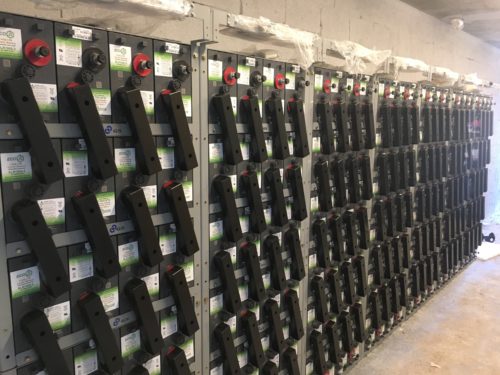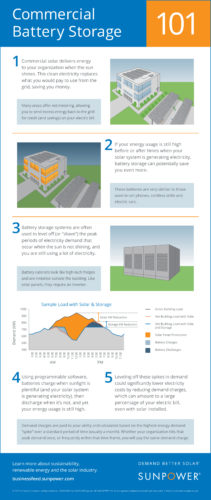Equipped with the benefits of both lithium-ion and lead-acid, nanocarbon batteries are an increasingly popular choice for solar
Experienced battery manufacturers know that each chemistry has its own fit in the market. Nanocarbon batteries are one growing piece of the storage spectrum.
GS Yuasa is a Japanese company that has been making batteries for more than a century. Its batteries can be found right under your nose in motorcycles, residential Internet access, or above in satellites and the International Space Station.
“It’s the batteries that you never see that are actually a big part of what we do,” said Eric Gallant, director of business development at GS Battery USA, an American subsidiary of GS Yuasa.

Credit: GS Battery
It takes all chemistries to make solar go ’round
With its experience in diverse market segments, GS knows different batteries are better at different jobs, so it offers four types for solar.
“Each battery does have a really unique set of values,” Gallant said.
He explained that lithium-ion batteries are good for applications that involve a lot of fast charging or discharging, such as when utilities are doing frequency and voltage support. Nickel-cadmium batteries are resistant to mistreatment and can bounce right back after overdischarge or overtemperature, which make them great for high-temperature, industrial applications anddesert-based systems. Lead-acid batteries have been around a long time and are well studied. Valve-regulated lead-acid (VRLA) absorbed glad mat (AGM) batteries, in particular, are sealed so they don’t need much maintenance.
“Lead-acid batteries are relatively inexpensive and can be a good starting place for someone just getting into renewable energy storage and doesn’t want to sink a bunch of money into it,” Gallant said. “They may need something small today, but a couple years down the road they might want to upgrade.”
Sulfation is killing our batteries
One possible way to upgrade would be to switch to a VRLA with nanocarbon added.
“It charges faster and cycles more than the typical lead-acid battery, and that opens up a lot of different possibilities for the technology,” Gallant said.
The primary way that lead batteries fail is due to sulfation. This occurs when lead batteries sit at a partial state of charge (less than 100%), and crystals form in the battery’s electrolyte. Eventually, the crystals become so large that the battery can’t charge or discharge and is basically dead. Most people may have experienced this with a car or boat battery.
Adding nanocarbon reduces the formation of the crystals. If a regular lead-acid battery is thought of as a flat sheet of paper, adding nanocarbon makes it more like sandpaper. Sandpaper has a larger surface area because of its crevasses. The nanocarbon “crevasses” keep crystals from growing too large in the battery. Instead, the crystals go back into the electrolyte, significantly slowing sulfation. More surface area also allows for quicker charging and recharging of the battery.

See how commercial battery storage works in this infographic from SunPower’s Business Feed (Click to enlarge)
Arbitrage is not arbitrary
Nanocarbon batteries’ ability to slow sulfation and remain in a partial state of charge make them ideal for commercial energy arbitrage applications.
“When the utility charges you for electricity at your house, it’s usually the same price per kilowatt hour regardless of when you use that power or how much,” Gallant explained. “If you’re a commercial enterprise, the utility finds a lot of other ways to tack on additional charges.”
Commercial consumers used to pull energy from generators to avoid higher rates if they approached a set threshold. Now they can use batteries.
“If you’re getting close to a peak demand threshold and at risk of falling into the higher rate, you can switch over to the battery instead of continuing to draw energy from the grid,” said Gallant. “This is a big deal since peak-demand charges make up as much as 40 or 50% of commercial customers’ power bills in some areas of the country. Adding batteries is a really economical thing to do and pays for itself really quickly. And it’s an application nanocarbon is well-suited for.”
Nanocarbon loves living off the grid
OutBack Power also offers nanocarbon battery options with its inverters. Eric Hill, director of energy storage and systems at OutBack’s parent company Alpha Technologies, said that another good fit for nanocarbon batteries is off-grid applications, or in states with self-consumption incentives like California. Though it’s very difficult to fully recharge batteries in these applications, nanocarbon stands up to the challenge.
“Not being able to get a full recharge back on traditional lead-acid batteries after a discharge would accelerate grid corrosion and lead to early failure,” Hill said. “But nanocarbon actually thrives in this partial state of charge condition where a full recharge isnt always possible.”
The nation is crazy for nano
OutBack offers multiple storage options with its inverters, such as traditional VRLA AGM and flooded lead-acid. It acknowledges the importance of being able to offer various energy storage options to fit the correct applications.
OutBack has offered nanocarbon batteries for just over two years, but Hill said the technology has quickly become popular.
“Nanocarbon is by far our most popular technology,” he said. “It helps fill the gap that exists between lithium-ion and lead-acid right now, because consumers want all the benefits of both—safety, price, recyclability. Consumers are looking for a happy medium between both, and nanocarbon provides that bridge.”





I don’t know if this is vaporware or not. Back in 2018 there was BIG NEWS from a company called Tydrolyte. This company claims they have a electrolyte solution that can replace sulfuric acid in lead/acid batteries that decreases dramatically the sulphation this chemistry creates. The problem I have is the web site states it is a direct replacement for acid and has the same properties. Yet it is also claimed the CEO put a drop of tydrolyte on his tongue and cheek and no acid burns. Since the introduction, I have not heard of any lead acid battery manufacturer using Tydrolyte instead of sulfuric acid. Is there something Tydrolyte is not telling us? IS this just another case of vaporware?
Modular Solutions with micro grid inverter integrated to a solar panel and compact low charge and discharge battery is the need of the day and would find lots of application